Recipes
The Best Limoncello Recipe (We Tested 5 Versions!)
Editors Note: I think I was a bit grumpy when I wrote this article. The problem is most limoncello recipes out there are utter garbage – at least not scientific at all. “Use the zest of 4 lemons” – What does that even mean?! I’ve tried to be very specific here to hopefully take some of the guesswork out of the process (after all, you’ll be waiting months before you can drink it, so it better be good😊 ).
Looking for a refreshing summer drink that’s easy to make?
This sweet, tangy liqueur hails from the Amalfi Coast in Southern Italy, where it has been made for generations. Traditionally, it is served ice-cold as a digestif after a meal, but it is also a popular ingredient in cocktails.
But did you realize limoncello is easy to make and only takes 3 ingredients?
The best limoncello is made from 20 grams / 0.75oz of lemon peel (Organic, Sorento and Meyer work best). Infuse for a week with 300ml of 95% vodka like Everclear. Once infused, filter through a coffee filter and add another 600ml of water and 200 grams of sugar to make 1L of final Limoncello.
Keep reading as we share out tips and tricks to make the perfect limoncello
Alternative: Check out our limecello recipe here, and arancello recipe here.

Table of Contents
How to Make Homemade Limoncello – The Base Recipe
Making limoncello is actually quite easy, and the results are well worth the effort.
In this recipe, i’ll describe the ingredients and process for making 1L of final limoncello at ~30% ABV, but you can scale this as needed. The photographs below show me making a 5L total batch.
Here’s what you’ll need:
Kitchen Tools and Equipment for Making Limoncello:
- A large glass jar with a lid
- A vegetable peeler or zester
- A fine-mesh strainer
- A funnel
- An airtight bottle or jar for storing the finished liqueur
Ingredients for 1L of Limoncello:
Lemoncello is typically bottled at 28 – 32% ABV, so we want to make our limoncello 30% to match.
- 30grams of lemon peel (That’s roughly 3 organic lemons worth)
- 500ml of 60% Neutral Spirit (or 750 ml high-quality 40% vodka)
- 200 grams of granulated white sugar
- 250ml ml water
Note: Adjust the amount of sugar based on your desired sweetness. 200 grams is on the low side so you may want to add another 50-100 grams later if needed.
Step 1: Peel Your Lemons
The first step in making limoncello is to peel the lemons. Use an organic variety, as you’ll be using the zest and you don’t want any pesticides or other chemicals in your finished product.
Most store-bought ‘un-organic’ lemons have wax on their skin to preserve them so you’ll want to avoid those ones.
Use a ‘calibrated’ vegetable peeler or zester to remove the zest from the lemons, being careful not to include any of the bitter white pith.
Pro Tip: I used a pair of pliers to bend the blade on my vegetable peeler, making the cut slightly shallower. This allowed me to only get the zest and none of the pith!
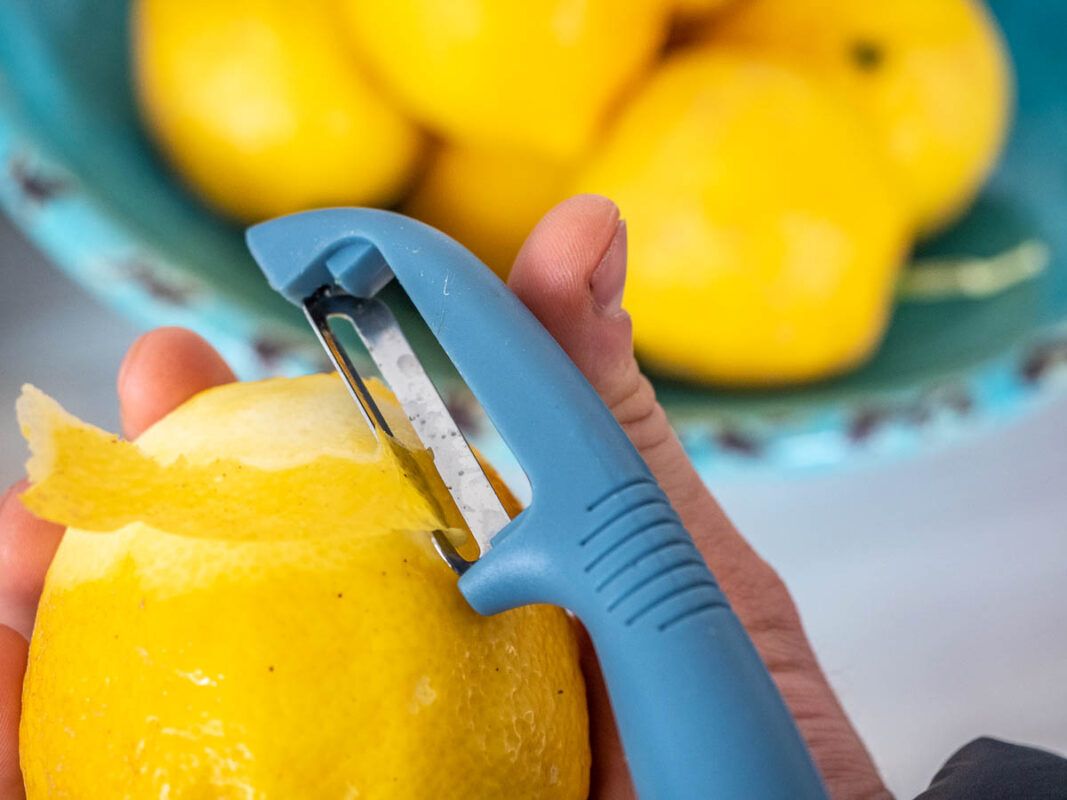
Step 2: Infuse the Lemon Peels in Alcohol
Next, you’ll need to infuse the lemon peels in alcohol. You can use any neutral spirit, such as vodka or Everclear, but we recommend using high-quality vodka for the best results.
There’s a bit of math to be done based on the ABV of your neutral, and the amount of water to add to get the right concentration at the end.. but more on that later.
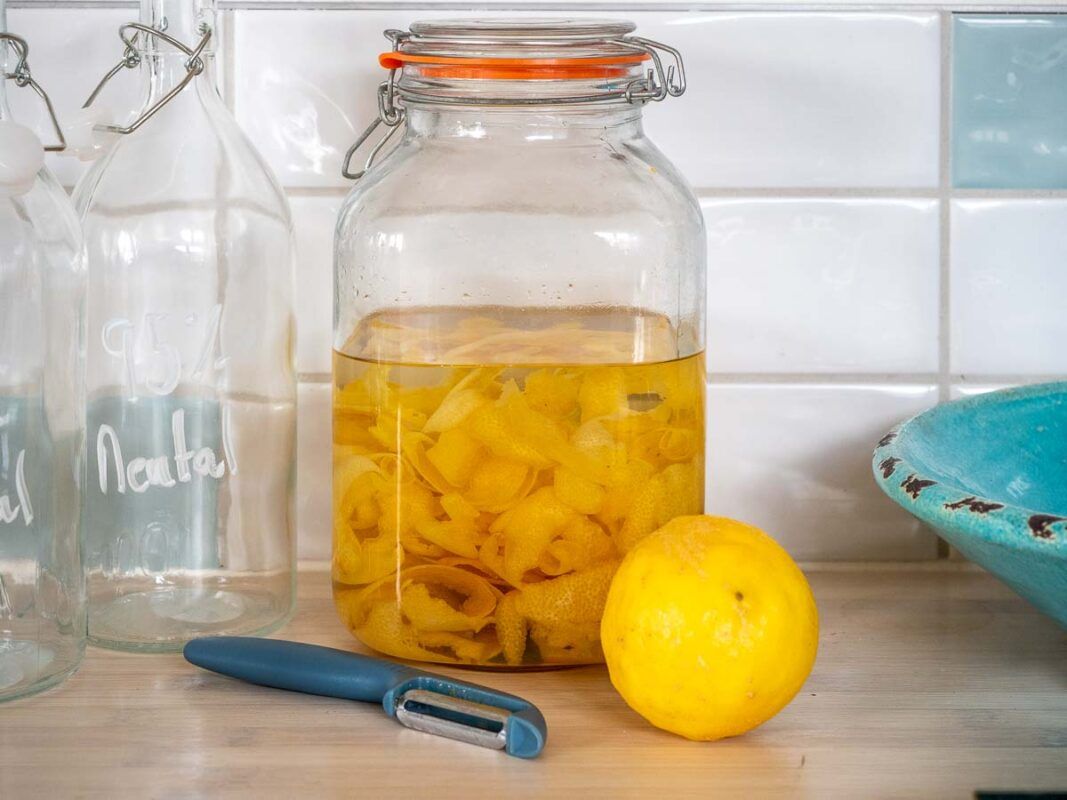
Step 4: Leave for one to four weeks
let the mixture sit for about a week or two to allow the flavors to meld together. Be sure to give it a good shake every day to keep everything evenly distributed.
- if you’re using 95% alcohol then a week is enough for full extraction.
- If you’re using 40% ABV vodka then you’ll need at least a month
Step 5: Strain and Filter
Once infused, it’s time to strain the lemon and alcohol mix to get rid of the zest and any particulate that may have come out. Use a fine-mesh strainer to remove any solids, then pass through a coffee filter to get rid of the extra fine particles.
I use a ceramic filter here because it’s easy to clean, but that totally overkill – a coffee filter works just fine 🙂
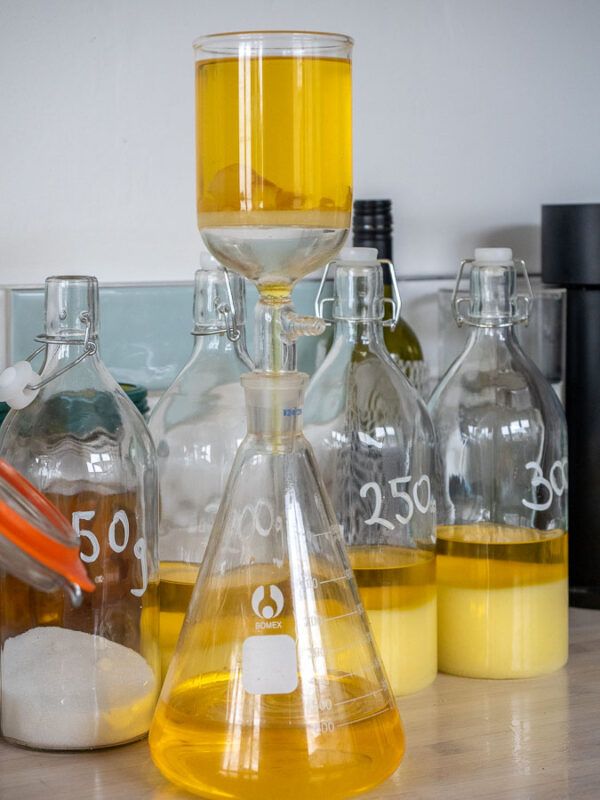

Step 4: Sweeten with Simple Syrup or Sugar
Now its time to sweeten the mixture. You can use simple syrup or sugar, depending on your preference.
Simple Syrup vs. Sugar
While it’s a bit more faffing around to make, the benefit of simple syrup is you’re guaranteed that all the sugar has disolved. With just adding sugar directly to the alcohol you’ll have a bit of trouble getting it to disolve otherwise (but it will eventually – with enough persuasion 🙂 )
Simple syrup is easier to mix and get dissolved which may lead to a more consistent finished product, but granulated sugar is a bit easier and is the traditional way of making limoncello.
How Much Sugar To Use:
I decided to put to the test exactly how much sugar is needed for the perfect limoncello. In the photo below you’ll see I tried 5 different variations for a 1L brew. These were;
- 100g
- 150g
- 200g
- 250g
- 300g

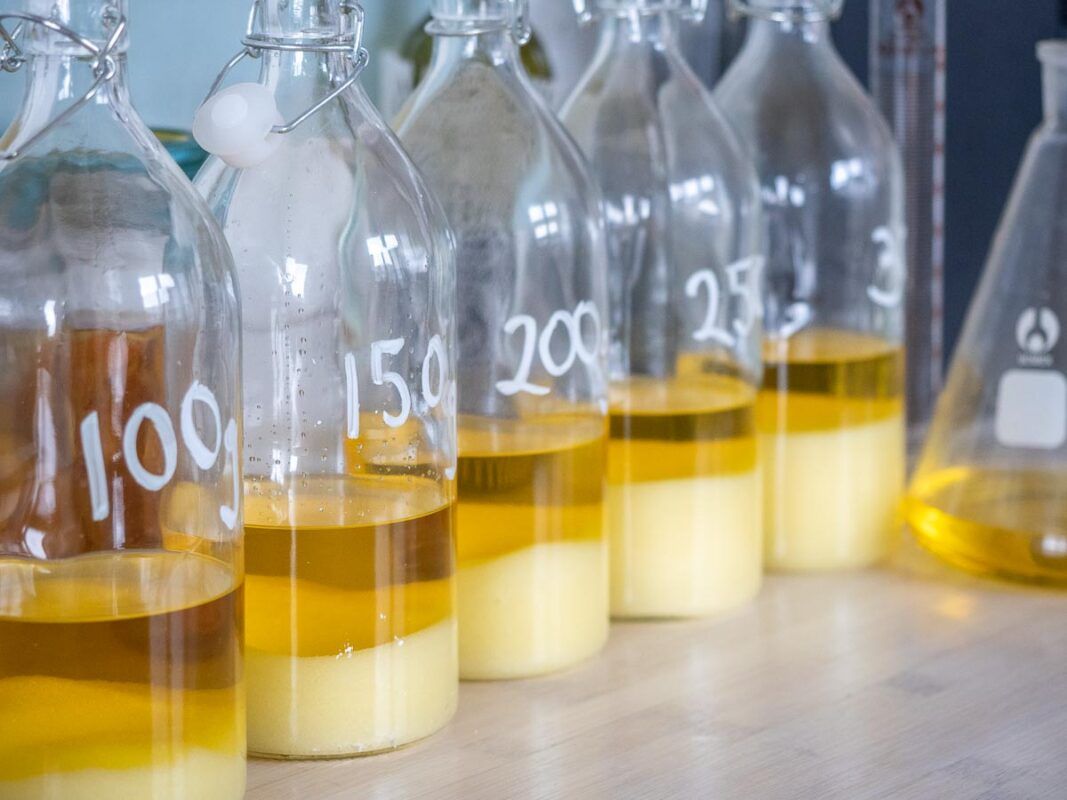
Step 5: Cut With Water
Because we worked out the right amount of alcohol to use at the beginning, we don’t need to do any fancy math to work out how much water to add. Just add the difference to make it up to the required batch size 🙂
In my case, I’ve used 1L bottles and have followed the recipe to make 1L of limoncello, so I just fill the rest of the bottle with water and shake to disolve.
This means adding roughly 600ml of water.
I say roughly because the amount will vary slightly based on how much sugar is used, and a few other factors.
(NB: If using 40% vodka instead of neutral like I did, then you’ll want to add 250ml of water instead)
The alcohol content of your limecello will affect both the flavor and the shelf life of the finished product. Here are the pros and cons of each alcohol percentage:
| Vodka Strength | Amount of Vodka Used | Amount of Water To Add (Approx) |
|---|---|---|
| 40% | 750 ml | 250 ml |
| 50% | 600 ml | 400 ml |
| 75% | 400 ml | 600 ml |
Step 5: Bottling and Storage
Transfer the liqueur to an airtight bottle or jar.
It’s a good idea to choose bottles with a good airtight seal, like a cork, screw cap or silicone gasket (as pictured).
You want to keep the limoncello away from sunlight and oxygen – the two biggest factors when it comes to preserving the taste for months (or years) to come.
How long with your homemade Limoncello last?
There’s no firm guidance on this. Because of the alcohol concentration, limoncello can last forever but the flavor will degrade over time based on how you choose to store it.
I’d recommend in a cool dark place your limoncello will last at least a year. If you choose to keep yours in the freezer (as many italians like to drink it ice cold) then it can well last 3+ years.

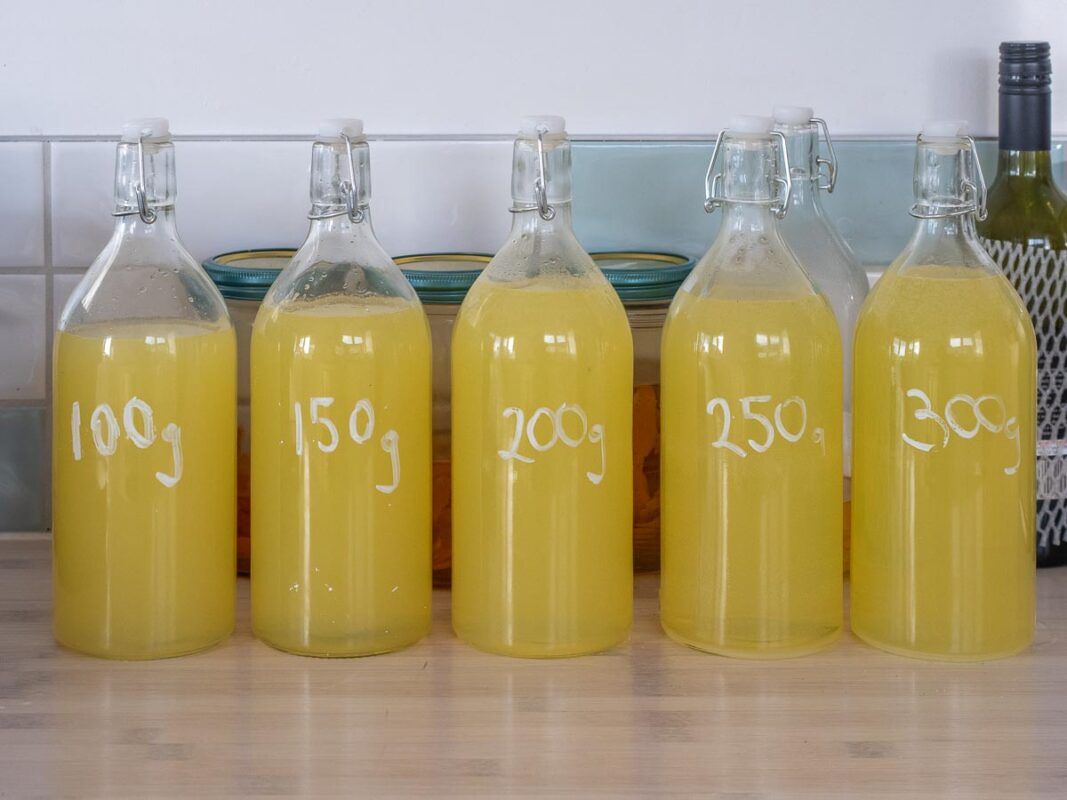
Extra Step (Optional): Racking the Sediment
This one depends if you want your limoncello to look crystal clear or not.
I’ve found no matter how well I filter the alcohol at the beginning I still end up with a cloudy limoncello – not crystal clear like the bought ones.
The way to fix this is to allow the bottle to settle and then ‘rack’ off the clear limoncello, leaving behind the sediment at the bottom of the bottle.
If you are leaving it at room temperature, this will take about a month. If you’re leaving it in the fridge, then wait a week.
Done! Now you have a bottle of limoncello better than you can buy, and maybe rivaling the italian nonas.
The Best Limoncello Recipe
Equipment
- A large glass jar with a lid
- A vegetable peeler or zester
- A fine-mesh strainer
- A funnel
- An airtight bottle or jar for storing the finished liqueur
Ingredients
- 3 organic lemons
- 300 ml of 95% Neutral Spirit or 800 ml high-quality 40% vodka
- 200 grams of granulated white sugar
- 200 ml water
Instructions
Step 1: Peel Organic Lemons
- The first step in making limoncello is to peel the limes. Use an organic variety, as you'll be using the zest and you don't want any pesticides or other chemicals in your finished product. Use a vegetable peeler or zester to remove the zest from the lemons, being careful not to include any of the bitter white pith.
Step 2: Infuse the Lemon Peels in Alcohol
- Next, you'll need to infuse the lemon peels in alcohol. You can use any neutral spirit, such Everclear, or us a high-quality vodka but the process will take longer
- There's a bit of math to be done based on the ABV of your neutral, and the amount of water to add to get the right concentration at the end.. but more on that later.
Step 3: Sweeten with Simple Syrup or Sugar
- Once the lemon peels have infused into the alcohol, it's time to sweeten the mixture. You can use simple syrup or sugar, depending on your preference.
- Simple syrup is easier to mix and get dissolved which may lead to a more consistent finished product, but granulated sugar is a bit easier and is the traditional way of making limoncello.
Step 4: Leave to Infuse
- After you’ve added the sweetener, let the mixture sit for about a moth week or two to allow the flavors to meld together. Be sure to give it a good shake every day to keep everything evenly distributed.
Step 5: Strain and Enjoy
- Finally, it's time to strain the limoncello and bottle it up for storage. Use a fine-mesh strainer to remove any solids, then transfer the liqueur to an airtight bottle or jar. Store it in the refrigerator for up to a month, or in the freezer for longer storage
Notes
What Type of Alcohol to Use in Limoncello?
As we mentioned earlier, you can use any neutral spirit to make limoncello. Here are the pros and cons of each type of alcohol:
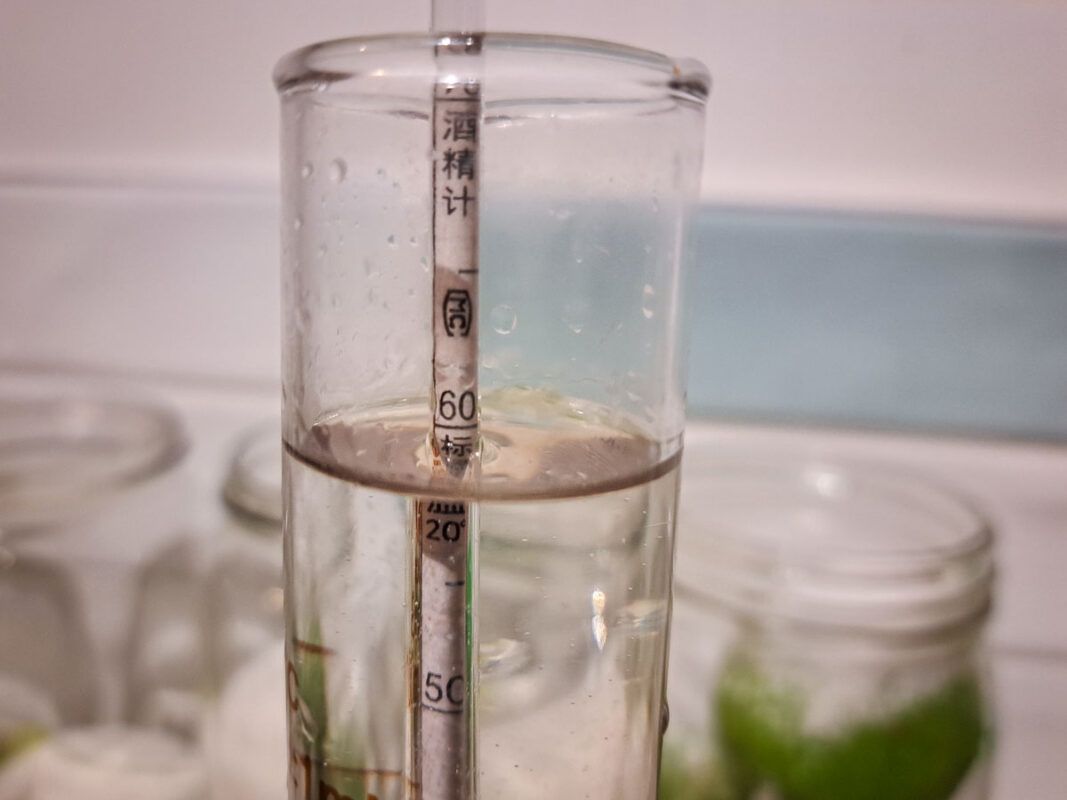
1. Neutral Spirit
A neutral spirit, such as grain alcohol, will give you the purest lemon flavor. However, it can also be quite harsh and may require more sweetener to balance it out.
Learn More: if you want to learn to make your own neutral spirit, start with this article here.
2. Store Bought Vodka
Vodka is the most popular choice for making limoncello, and for good reason. It’s smooth, easy to find, and has a neutral flavor that won’t overpower the lemon.
3. Everclear (Best Option)
If you’re looking for a high-proof option, Everclear is a popular choice. However, it can be difficult to find and may be too strong for some people’s tastes.
What Percentage Alcohol is Best?
The alcohol content of your limoncello will affect both the flavor and the shelf life of the finished product. Here are the pros and cons of each alcohol percentage:
Infusion Time: Using higher proof/ABV alcohol will speed up the time it takes for the lemon peel to infuse in the limoncello
Final ABV: We want our final limoncello to be around 30% ABV (or 60 proof). The table below will explain how much water to alcohol you’ll need for your limoncello. Alternatively, use this spirit dilution calculator here.
| Vodka Strength | Amount of Vodka | Amount of Water | Infusion Time |
|---|---|---|---|
| 40% | 750 ml | 250 ml | 4 – 8 weeks |
| 45% | 667 ml | 333 ml | 4 – 8 weeks |
| 50% | 600 ml | 400 ml | 4 weeks |
| 55% | 545 ml | 455 ml | 4 weeks |
| 60% | 500 ml | 500 ml | 4 weeks |
| 65% | 462 ml | 538 ml | 2 – 3 weeks |
| 70% | 429 ml | 571 ml | 2 – 3 weeks |
| 75% | 400 ml | 600 ml | 2 – 3 weeks |
| 80% | 375 ml | 625 ml | 2 – 3 weeks |
| 85% | 353 ml | 647 ml | 1 week |
| 90% | 333 ml | 667 ml | 1 week |
| 95% | 316 ml | 684 ml | 1 week |
40% or 80 proof
This is the most common alcohol percentage for limoncello, and it will give you a smooth, drinkable liqueur with a shelf life of about a month.
60% or 120 proof
A higher alcohol percentage will give you a stronger, more potent liqueur. However, it may be too strong for some people’s tastes.
75% or 151 proof (like Everclear 151)
This is the highest alcohol percentage you can use, and it will give you a very strong, almost medicinal liqueur. It’s not recommended for casual sipping, but it can be a good choice for making cocktails.
What Type of Sugar to Use?
You can use any type of sugar to sweeten your limoncello, but we recommend using high-quality white sugar or simple syrup. Brown sugar or other flavored sugars may alter the flavor of the finished liqueur.
What Are The Best Lemons to Use?
Some of the best lemons for making limoncello are Sorrento or untreated lemons. These lemons have thick and fragrant skin that is perfect for creating the essential oils needed for limoncello. Additionally, Emily W. from Cookindocs recommends using Eureka, Lisbon, or Meyer lemons as alternatives to Sorrento lemons.
Tip: all the flavor you’ll be infusing comes from the oil in the zest, so scratch the skin with your fingernail and smell it to tell how vibrant the flavor is.
- Meyer lemons:
Meyer lemons are a cross between a lemon and a mandarin orange, which makes them sweeter and less acidic than regular lemons. They have thin skin and a floral taste that is perfect for making limoncello. However, because they are sweeter, you may need to adjust the amount of sugar used in your recipe. - Sorrento lemons:
Sorrento lemons are grown in the Sorrento region of Italy and are known for their thick and fragrant skin. They have a higher oil content than other lemons, which makes them perfect for creating the essential oils needed for limoncello. Sorrento lemons are also less acidic than other lemons, which gives them a smoother taste. - Organic lemons:
Organic lemons are grown without the use of pesticides or other chemicals, which makes them a great choice for making limoncello. Because they are grown without chemicals, they have a more natural and intense flavor than conventionally grown lemons. However, they may be more expensive and harder to find than other types of lemons.
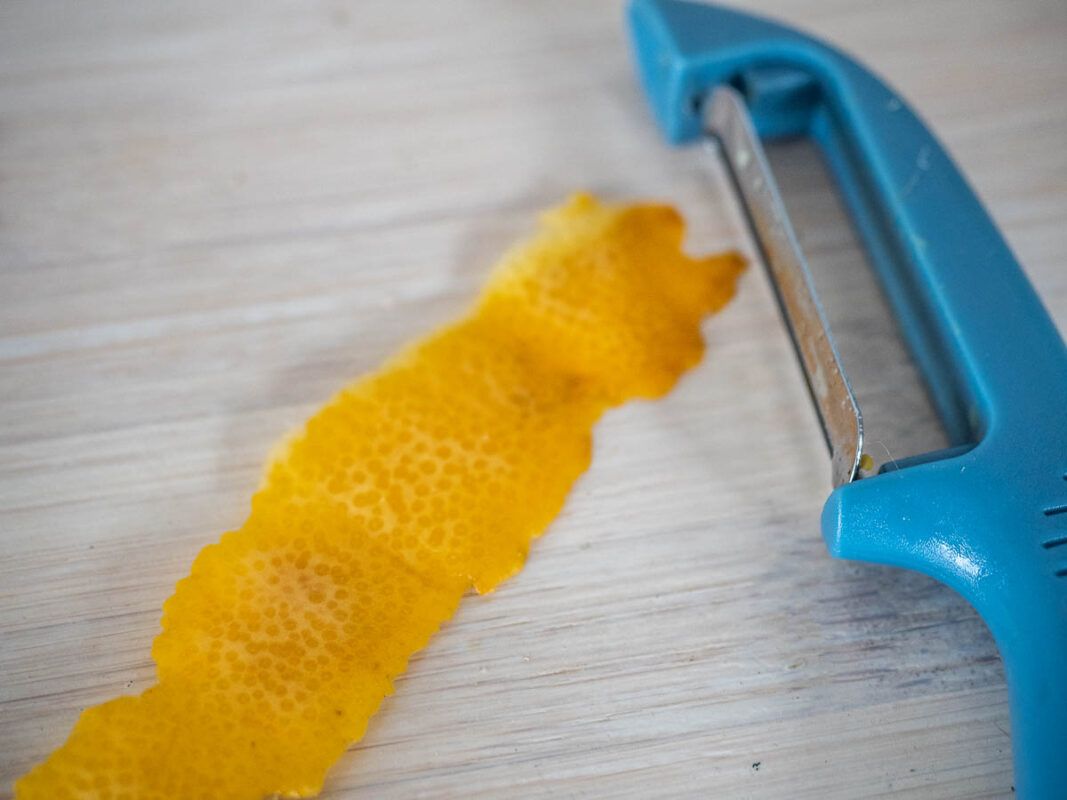

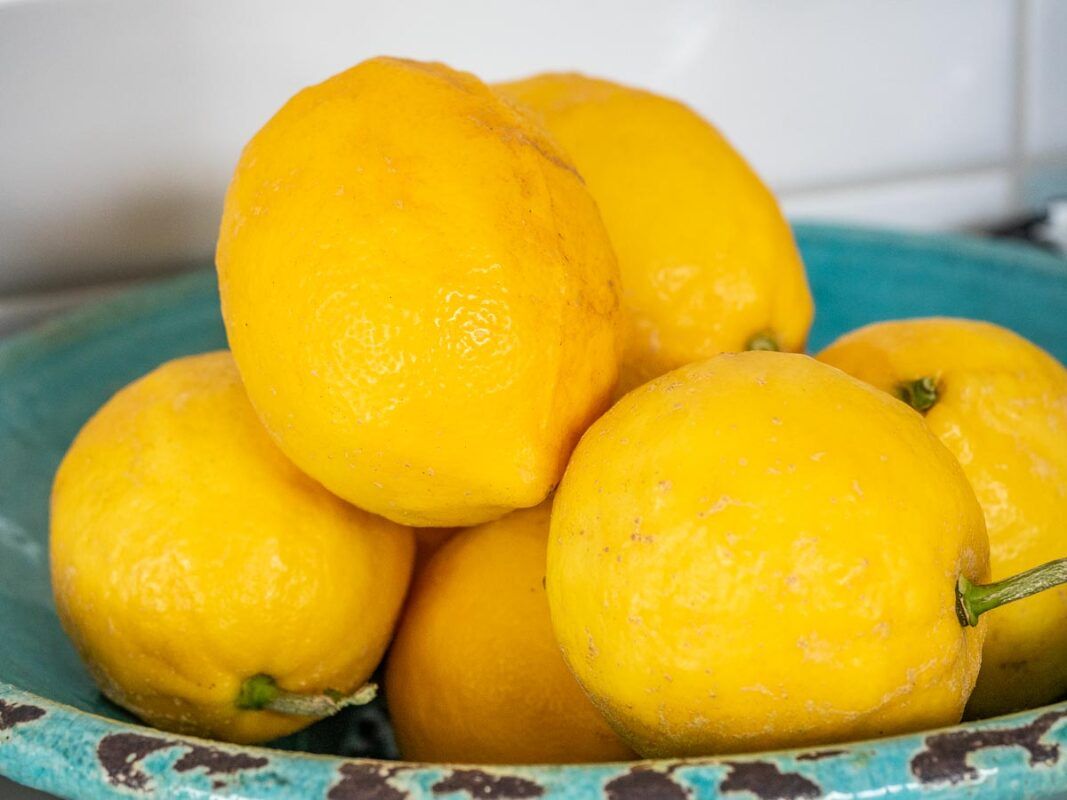
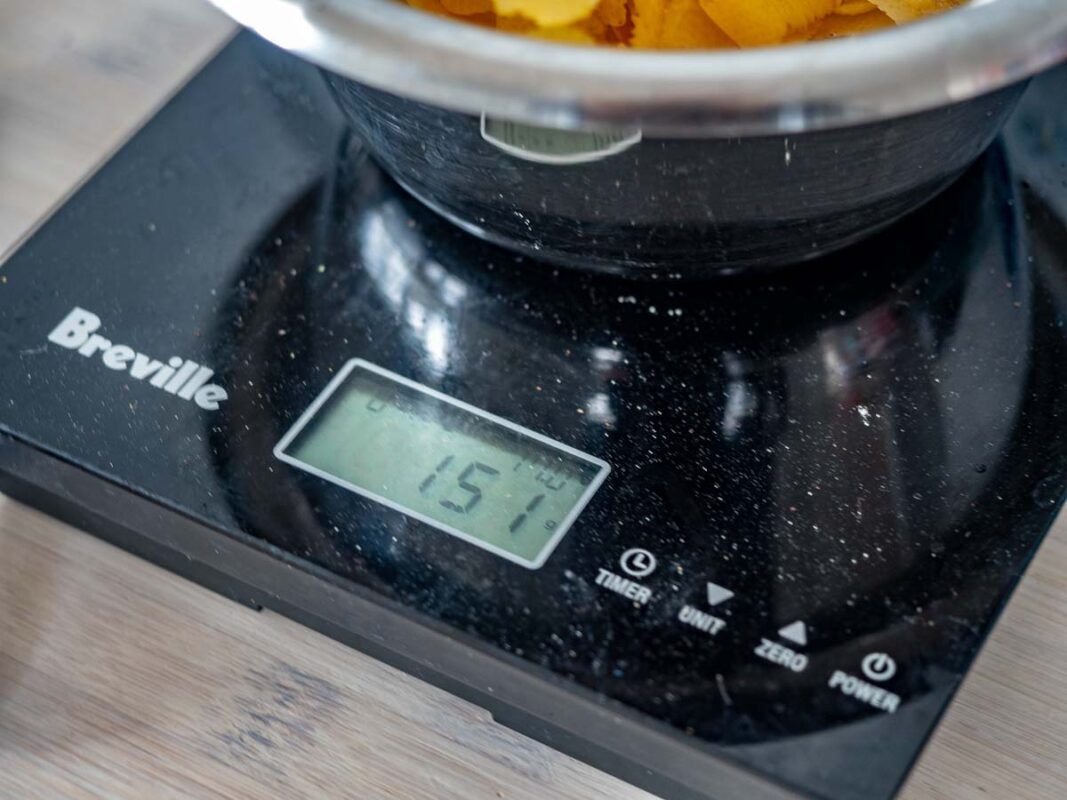

How Long Do You Infuse Homemade Limoncello?
The length of time you infuse your limoncello will affect the flavor and strength of the finished product. We recommend infusing for at least a week, but you can leave it for up to a month if you want a stronger flavor.
Here is a table of infusion times based on the ABV of the vodka used:
| Vodka/Neutral Strength | Infusion Time |
|---|---|
| 40% or 80 proof | 45 days |
| 60% or 120 proof | 30 days |
| 75% or 151 proof (like Everclear 151) | 14 days |
| 95% or 190 proof (Recommended) | 7 days |
Note that these are general guidelines, and you should always taste the mixture as you go to determine when it’s ready. The higher the ABV, the shorter the infusion time will be.
How Much Sugar Do You Add to Limoncello?
The amount of sugar you add to your limoncello will depend on your personal preference. Start with a small amount, and add more slowly, tasting as you go, until you achieve the desired level of sweetness. We recommend using about 1 cup of sugar per 750 ml bottle of alcohol.

Bottling and Storage
Once you’ve strained your limoncello, it’s time to bottle it up for storage. Use a funnel to transfer the liqueur to an airtight bottle or jar, and store it in the refrigerator or freezer. Here are some common questions about bottling and storing limoncello:
Is My Homemade Limoncello Supposed to be Cloudy?
Yes, it’s normal for homemade limoncello to be cloudy. This is due to the natural oils in the lemon zest, and it won’t affect the flavor or quality of the finished product.
What’s the Best Way to Bottle Homemade Limoncello?
We recommend using glass bottles or jars with airtight lids. Make sure they are clean and dry before filling them with your finished limoncello.
Do You Have to Keep Homemade Limoncello in the Refrigerator?
It’s not strictly necessary to keep your limoncello in the refrigerator, but it will help prolong its shelf life. If you plan to drink it within a month or so, you can keep it at room temperature.
How Long Does Homemade Limoncello Last?
Properly stored, homemade limoncello can last for a year or more in the freezer. However, it’s best enjoyed within the first few months for optimal flavor. I’d also suggest you leave it for a month or two for the flavor to mellow and the sediment to settle.
Final Thoughts
Homemade limoncello is a fun and easy project that yields delicious results. Whether you’re sipping it on its own or using it in cocktails, this tangy, sweet liqueur is sure to become a summer favorite. So, grab some organic lemons and your favorite vodka, and get ready to enjoy the best limoncello you’ve ever tasted!

Limoncello FAQ: All Your Questions Answered
Here are some common questions about our limoncello, along with our expert answers:
Q. What Are The Best Lemons for Limoncello?
We recommend using any organic lemons but in particular sorento or Meyer lemons with a bright, fresh scent will yield the best flavor. Watch out for some store-bought non-organic lemons as these may have wax on the rind which won’t taste good.
Q. What to Do with Lemons After Making Limoncello?
Don’t throw away those leftover lemons! You can use the juice and pulp for cooking or baking, or make a refreshing lemonade.
Q. How to Best Serve Limoncello
Limoncello is traditionally served ice-cold as a digestif after a meal, but it’s also a popular ingredient in cocktails. Try mixing it with soda water or tonic water for a refreshing summer drink.
Serve chilled: Limoncello is traditionally served chilled, straight from the freezer or refrigerator. This helps to enhance the flavor and aroma of the lemon.
Serve in a chilled glass: To keep your limoncello cold for longer, you can also serve it in a chilled glass. Place the glass in the freezer for a few minutes before serving to keep it extra cold.
Serve as a digestif: Limoncello is often served as a digestif, or after-dinner drink, to help aid in digestion. Serve it in a small glass after a meal to enjoy its refreshing taste.
Serve with a twist: For a fun twist on traditional limoncello, you can serve it with a splash of soda water or tonic water. This helps to cut the sweetness of the limoncello and adds a bit of fizz.
Serve with dessert: Limoncello pairs well with many desserts, such as fruit tarts, cheesecake, or sorbet. Serve a small glass of limoncello alongside your favorite dessert for a delicious and refreshing combination. (sources: wikiHow, The Mediterranean Dish)
Q. What’s the Best Base Alcohol/Vodka to Use?
Vodka is the most popular choice for making limoncello, but you can use any neutral spirit you like. Like we mentioned above, the trick is finding some neutral spirit that’s as high ABV as possible. You could distill your own, or buy Everclear.
Q. What Is The Alcohol Content of Limoncello?
The alcohol content of your limoncello will depend on the type of alcohol you use and the amount of sweetener you add. Most limoncello recipes have an alcohol content of around 28-32%.
Q. How Long to Infuse Lemon Peels?
We recommend infusing your lemon peels for at least a week, but you can leave them for up to a month for a stronger flavor.
Q. Can I Use Other Types of Sugar?
You can use any type of sugar you like to sweeten your Limoncello, but we recommend using high-quality white sugar or simple syrup.
Q. How to Store Limoncello
Store your limoncello in an airtight bottle or jar in the refrigerator or freezer. Properly stored, it can last for up to a year.
Q. Will Limoncello Freeze?
Yes, limoncello will freeze if stored at a low enough temperature but most domestic freezers aren’t cold enough. It’s common for people to keep their limoncello in the freezer.
Freeze or not it will not affect the quality or flavor of the liqueur.
Q. How to Make Limoncello Cream
For a creamy twist on classic limoncello, try making limoncello cream. Simply mix equal parts limoncello and heavy cream, shake with ice, and strain into a glass. Garnish with a lemon twist and enjoy!

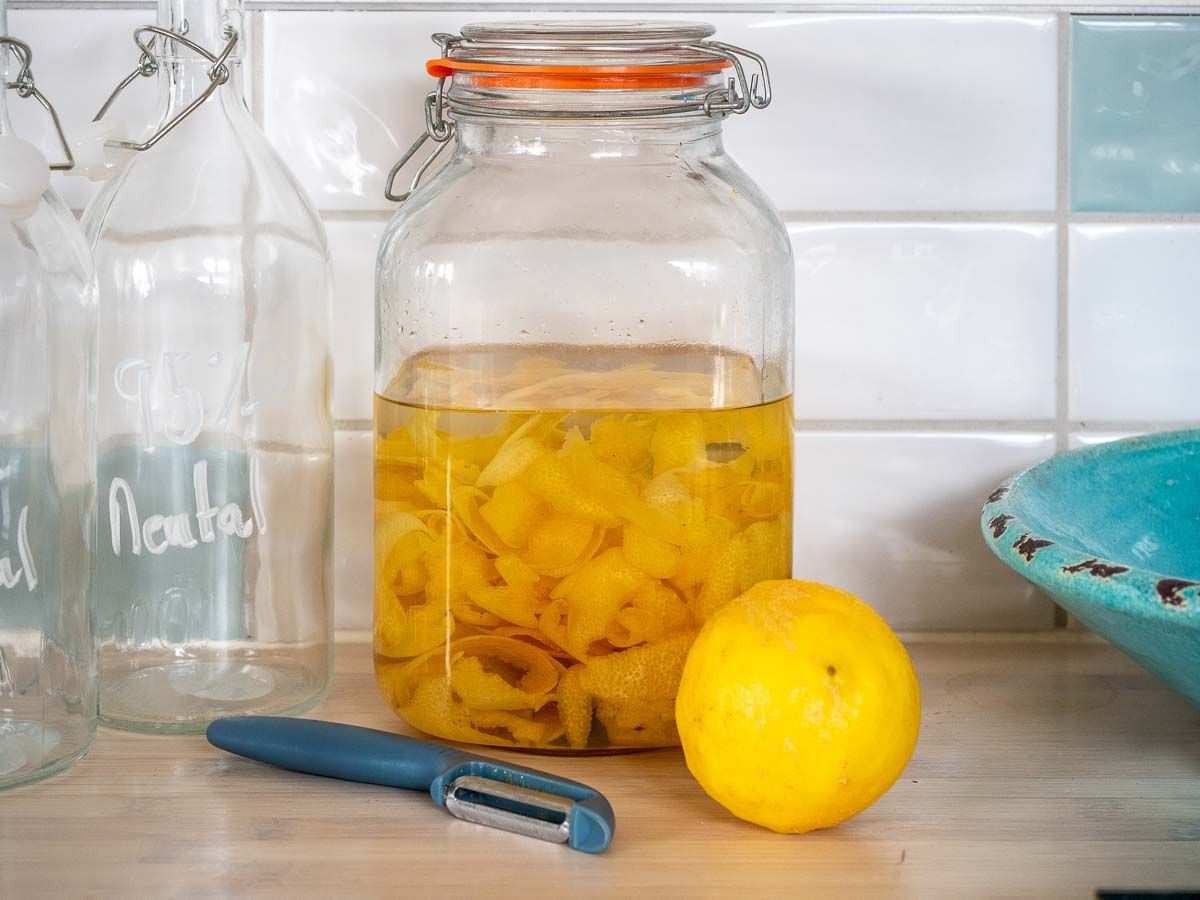








Hi there, I’m trying this right now. I can’t find at what point in the process I am supposed to add the water. Thanks!
Hi Tracy, sorry for the confusion. I’ve edited the recipe to make things a bit more clear now. In short, add water after you’ve strained the lemon and added the sugar (the final step).
Wonderful, thank you!!